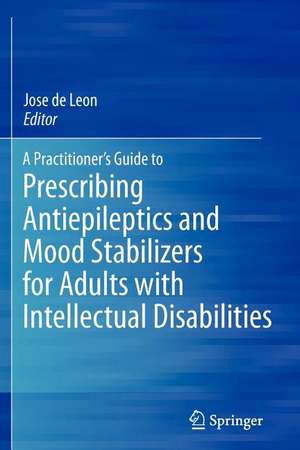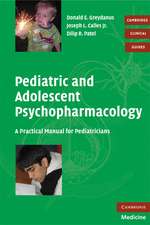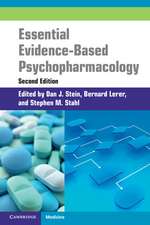A Practitioner's Guide to Prescribing Antiepileptics and Mood Stabilizers for Adults with Intellectual Disabilities
Editat de Jose de Leonen Limba Engleză Paperback – 2 mar 2012
A Practitioner's Guide to Prescribing Antiepileptics and Mood Stabilizers for Adults with Intellectual Disabilities provides a detailed framework for prescribing for this challenging population. Featuring the most up-to-date information on factors that inform prescribing, the Guide addresses basic issues and controversies (e.g., the rift between evidence-based and personalized medicine) in treating adults with cognitive deficits. Clients' specific needs are emphasized in developing appropriate and effective pharmacological intervention for improved outcomes and quality of life. Drugs discussed in the Guide include carbamazepine, clonazepam, diazepam, ethosuximide, felbamate, gabapentin, lacosamide, lamotrigine, levetiracetam, lithium, lorazepam, oxcarbazepine, phenobarbital, phenytoin, pregabalin, primidone, rufinamide, tiagabine, topiramate, valproate, and zonisamide. For each of these compounds, the guidelines cover:
- Indications for use; relative and absolute contraindications.
- Assessment during treatment; therapeutic drug monitoring; warning signs and symptoms for caretakers.
- Dosage: administration; initial and maximum recommended dosage; modifications associated with drug-drug interactions, personal characteristics, and (where appropriate) genetic variations.
- Adverse drug reactions: common, relatively uncommon, and potentially lethal, plus risk of metabolic syndrome.
- Guidelines for discontinuation.
- References, tables, and drug utilization reviews.
Preț: 729.06 lei
Preț vechi: 767.42 lei
-5% Nou
Puncte Express: 1094
Preț estimativ în valută:
139.55€ • 151.63$ • 117.30£
139.55€ • 151.63$ • 117.30£
Carte tipărită la comandă
Livrare economică 21 aprilie-05 mai
Preluare comenzi: 021 569.72.76
Specificații
ISBN-13: 9781461420118
ISBN-10: 1461420113
Pagini: 540
Ilustrații: XXXI, 507 p.
Dimensiuni: 155 x 235 x 28 mm
Greutate: 0.75 kg
Ediția:2012
Editura: Springer
Colecția Springer
Locul publicării:New York, NY, United States
ISBN-10: 1461420113
Pagini: 540
Ilustrații: XXXI, 507 p.
Dimensiuni: 155 x 235 x 28 mm
Greutate: 0.75 kg
Ediția:2012
Editura: Springer
Colecția Springer
Locul publicării:New York, NY, United States
Public țintă
Professional/practitionerCuprins
1. Introduction.- 2. A Practitioner’s Guide to Prescribing Carbamazepine for Adults with Intellectual Disabilities.- 3. A Practitioner’s Guide to Prescribing Clonazepam for Adults with Intellectual Disabilities.- 4. A Practitioner’s Guide to Prescribing Diazepam for Adults with Intellectual Disabilities.- 5. A Practitioner’s Guide to Prescribing Ethosuximide for Adults with Intellectual Disabilities.- 6. A Practitioner’s Guide to Prescribing Felbamate for Adults with Intellectual Disabilities.- 7. A Practitioner’s Guide to Prescribing Gabapentin for Adults with Intellectual Disabilities.- 8. A Practitioner’s Guide to Prescribing Lacosamide for Adults with Intellectual Disabilities.- 9. A Practitioner’s Guide to Prescribing Lamotrigine For Adults with Intellectual Disabilities.- 10. A Practitioner’s Guide to Prescribing Levetiracetam for Adults with Intellectual Disabilities.- 11. A Practitioner’s Guide to Prescribing Lithium for Adults with Intellectual Disabilities.- 12. A Practitioner’s Guide to Prescribing Lorazepam for Adults with Intellectual Disabilities.- 13. A Practitioner’s Guide to Prescribing Oxacarbazepine for Adults with Intellectual Disabilities.- 14. A Practitioner’s Guide to Prescribing Phenobarbital for Adults with Intellectual Disabilities.- 15. A Practitioner’s Guide to Prescribing Phenytoin for Adults with Intellectual Disabilities.- 16. A Practitioner’s Guide to Prescribing Pregabalin for Adults with Intellectual Disabilities.- 17. A Practitioner’s Guide to Prescribing Primidone for Adults with Intellectual Disabilities.- 18. A Practitioner’s Guide to Prescribing Rufinamide for Adults with Intellectual Disabilities.- 19. A Practitioner’s Guide to Prescribing Tiagabine for Adults with Intellectual Disabilities.- 20. A Practitioner’s Guide to Prescribing Topiramate for Adults with Intellectual Disabilities.- 21. A Practitioner’s Guide to Prescribing Valproate forAdults with Intellectual Disabilities.- 22. A Practitioner’s Guide to Prescribing Zonisamide for Adults with Intellectual Disabilities.- 23. A Practitioner’s Guide to Prescribing Non-oral Antiepileptics for Adults with Intellectual Disabilities.- 24. Conclusion.
Recenzii
From the reviews:
“A valuable contribution to the literature and helps fill several identified gaps. … The authors provide a well-balanced, extensive review of the literature, concisely yet thoroughly summarizing hundreds of articles into one user-friendly reference for the busy clinician. The authors present complex, detailed information in a well-organized, sophisticated yet easy-to-read style, enhancing the book’s clinical utility and applicability. … a valuable resource for a broad array of mental health and medical clinicians who treat epilepsy, mood disorders, and challenging behaviors in adult individuals with IDs.” (Rachel E. Myers, Journal of Child and Family Studies, Vol. 21, 2012)
“A valuable contribution to the literature and helps fill several identified gaps. … The authors provide a well-balanced, extensive review of the literature, concisely yet thoroughly summarizing hundreds of articles into one user-friendly reference for the busy clinician. The authors present complex, detailed information in a well-organized, sophisticated yet easy-to-read style, enhancing the book’s clinical utility and applicability. … a valuable resource for a broad array of mental health and medical clinicians who treat epilepsy, mood disorders, and challenging behaviors in adult individuals with IDs.” (Rachel E. Myers, Journal of Child and Family Studies, Vol. 21, 2012)
Textul de pe ultima copertă
Emotional, behavioral, and neuropsychiatric conditions are common in individuals with intellectual disabilities (IDs), most notably epilepsy, aggression, self-injurious behaviors, and bipolar and other mood disorders. Despite the prevalence of such problems, there is a scarcity in the literature of reliable information on medical treatments for those with IDs.
A Practitioner's Guide to Prescribing Antiepileptics and Mood Stabilizers for Adults with Intellectual Disabilities provides a detailed framework for prescribing for this challenging population. Featuring the most up-to-date information on factors that inform prescribing, the Guide addresses basic issues and controversies (e.g., the rift between evidence-based and personalized medicine) in treating adults with cognitive deficits. Clients' specific needs are emphasized in developing appropriate and effective pharmacological intervention for improved outcomes and quality of life. Drugs discussed in the Guide include carbamazepine, clonazepam, diazepam, ethosuximide, felbamate, gabapentin, lacosamide, lamotrigine, levetiracetam, lithium, lorazepam, oxcarbazepine, phenobarbital, phenytoin, pregabalin, primidone, rufinamide, tiagabine, topiramate, valproate, and zonisamide. For each of these compounds, the guidelines cover:
A Practitioner's Guide to Prescribing Antiepileptics and Mood Stabilizers for Adults with Intellectual Disabilities provides a detailed framework for prescribing for this challenging population. Featuring the most up-to-date information on factors that inform prescribing, the Guide addresses basic issues and controversies (e.g., the rift between evidence-based and personalized medicine) in treating adults with cognitive deficits. Clients' specific needs are emphasized in developing appropriate and effective pharmacological intervention for improved outcomes and quality of life. Drugs discussed in the Guide include carbamazepine, clonazepam, diazepam, ethosuximide, felbamate, gabapentin, lacosamide, lamotrigine, levetiracetam, lithium, lorazepam, oxcarbazepine, phenobarbital, phenytoin, pregabalin, primidone, rufinamide, tiagabine, topiramate, valproate, and zonisamide. For each of these compounds, the guidelines cover:
- Indications for use; relative and absolute contraindications.
- Assessment during treatment; therapeutic drug monitoring; warning signs and symptoms for caretakers.
- Dosage: administration; initial and maximum recommended dosage; modifications associated with drug-drug interactions, personal characteristics, and (where appropriate) genetic variations.
- Adverse drug reactions: common, relatively uncommon, and potentially lethal, plus risk of metabolic syndrome.
- Guidelines for discontinuation.
- References, tables, and drug utilization reviews.
Caracteristici
Examines a complex and neglected area of medicine – that is, treating adults with intellectual disabilities with anticonvulsants and mood stabilizers Offers uniquely comprehensive and practical guidelines Addresses both psychiatric (mood stabilizers) and neurological (anticonvulsants) drugs Each chapter provides a guideline that can be downloaded independently Each guideline is summarized in a drug utilization review
















